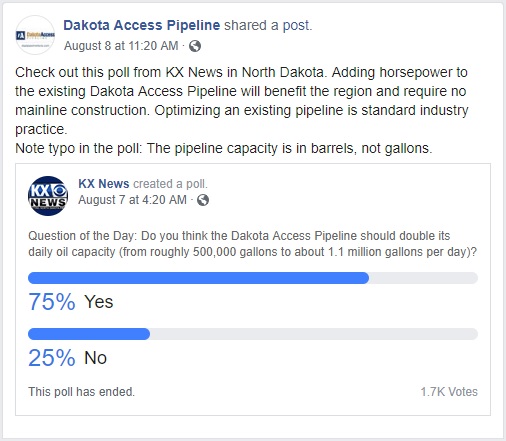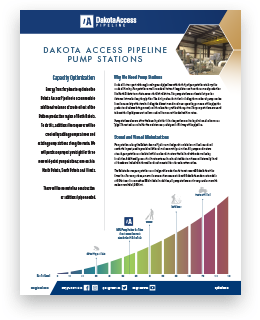Growth Opportunity
Energy Transfer held an open season in the fall of 2018 to obtain additional shipper commitments for capacity on the pipeline. The success of the open season highlighted the continued market demand and need for additional capacity out of the Bakken. To meet these needs, Energy Transfer is proposing to optimize the existing Dakota Access Pipeline to accommodate additional volumes of crude oil out of the Bakken production region of North Dakota.
The upgrade of the already permitted pipeline will help allow for further development in the Bakken, economic growth in North Dakota, and stabilization of costs for the industry and consumers.
Optimization Modifications
Optimizing the Dakota Access Pipeline to accommodate increased volumes can easily be done by adding horsepower along with a few modifications and upgrades at pump stations along the existing line. There will be no mainline construction or additional pipe needed. The maximum operating pressure will not change.
The additional horsepower will be created by adding pumps at new and existing pump stations along the route. We will purchase property outright for three new mid-point pump stations; one each in North Dakota, South Dakota and Illinois. Pumping equipment at each new pump station will be isolated within closed structures for additional environmental protection and sound mitigation. Specific to North Dakota, this work will require between $30 and $40 million in upgrades.
We will work closely with local, state and federal authorities to ensure we remain in full compliance with all applicable regulatory and permit requirements.
Benefits
Optimizing capacity will enable further development in the Bakken, which means more jobs and economic benefits for local communities. The installation of new pumps will generate sales tax revenue in each state, and the addition of three new pump stations will generate millions in property taxes that can be used by counties to support schools, hospitals, emergency services, and much more.
The pipeline has helped to improve the region's drilling economics by lowering transportation costs for operators and is providing a safer means of transportation over truck or rail.
Optimization Jobs
Over the course of the project, we estimate that up to 700 jobs will be created, not including the increased opportunities with the local electrical companies. Many of these jobs will be union tradesmen and women with LiUNA, IBEW and IUOE.
This breaks down as follows:
- Construction of each new pump station--one each in North Dakota, South Dakota and Illinois along DAPL--will employ 75-100 construction-related jobs over a period of 6 - 9 months. Each local electrical company will also employ skilled labor resources to install the infrastructure that will supply power to the new pump stations.
- In Illinois, work will include one new pump station along DAPL, one along ETCOP, and upgrades at the Patoka Terminal, totaling up to 300 jobs. In North Dakota, work at the existing Johnson's Corner tank site will employ 75 - 100 jobs—in additional to the jobs on the new pump station.
Dakota Access Pipeline Optimization Plan
The Dakota Access Pipeline is currently moving approximately half of the Bakken's oil output per day. Optimizing the existing pipeline by adding horsepower will help allow for further development in the Bakken, economic growth in North Dakota, and the stabilization of costs for the industry and consumers.
- Capacity optimization will require no mainline construction or additional pipe.
- Maximum Operation Pressure (MOP, definition used in DOT Part 195.2) of the pipe will not change.
- Adding three mid-point pump stations along the route.
- No route changes or additional easements needed.

